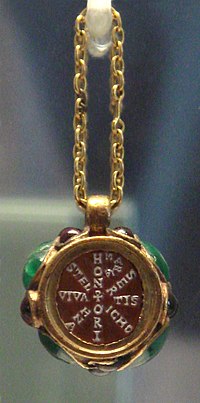Maria (died 407) was a Roman empress as the first wife of the Western Roman Emperor Honorius. She was the daughter of the general Stilicho. It is uncertain when she was born, but she must have been no older than fourteen at the time of her marriage. Maria had no children, and died in 407. After her death, Honorius married her sister Thermantia.
| Maria | |
|---|---|
 | |
| Roman empress | |
| Tenure | 398 – 407 |
| Born | c. 384 |
| Died | 407 Ravenna |
| Burial | |
| Spouse | Honorius |
| Dynasty | Theodosian |
| Father | Stilicho |
| Mother | Serena |

HONORI
MARIA
SERHNA
VIVATIS
STELICHO. and on the reverse,
STELICHO
SERENA
EUCHERI
THERMANTIA
VIVATIS
Family edit
Maria was a daughter of Stilicho, magister militum of the Western Roman Empire, and Serena. Her siblings were Eucherius and Thermantia. Maria’s unnamed paternal grandfather was a Romanized Vandal cavalry officer under the emperor Valens, while her unnamed paternal grandmother was a Roman.[1]
Her maternal grandfather was an elder Honorius, a brother to Theodosius I and son of Count Theodosius.[2] Genealogists consider it likely that Maria was named after her maternal grandmother, tentatively giving said grandmother the name "Maria".[3]
Marriage edit
In 398, Maria married Honorius, a cousin of her mother.[4] While Maria’s father Stilicho had been the one to arrange the marriage,[5] the poet Claudian denied his role, going as far as to claim that he was unwilling for it to occur.[6][7] He instead stated that the union had been arranged by Theodosius I prior to his death, and attributed its fulfillment to Honorius’ own initiative.[6][7]
Claudian wrote an Epithalamion and fescennine verses in celebration of the event.[4] He portrayed the occasion as being attended by several divine guests, such as comparing it to the pairing of Peleus and Thetis in Greek mythology,[8] as well as depicting the Roman goddess Venus as being the the matron of honor.[4]
The date of her parents’ marriage is usually given as the year 384,[9][10][11] meaning that Maria would be, at most, 14 years old at the time of her marriage.[3]
Empress edit
Although Claudian expressed hope that Maria would have a child,[12] that did not happen, which a number of ancient sources have noted.[13] Orosius attributed it to voluntary chastity, while Zosimus accused Maria’s mother Serena of plotting against Honorius. Cameron dismissed both tales, believing that Claudian’s writings proved Serena wanted the couple to have a child just as much as Stilicho.[14]
Maria was buried in Old St. Peter's Basilica in Rome when she died around the year 407. Shortly after, her sister Thermantia went on to marry Honorius.[15]
In the year 1544, Maria’s sarcophagus was identified through the approximately 180 valuable treasures buried with her, although only 2 of them remain known today.[16]
References edit
- ^ Jones, Martindale & Morris, p. 853.
- ^ Jones, Martindale & Morris, p. 441.
- ^ a b Jones, Martindale & Morris, p. 824.
- ^ a b c Wasdin 2014, p. 48.
- ^ Cameron 1970, p. 95.
- ^ a b McEvoy 2013, p. 160.
- ^ a b Cameron 1970, p. 99.
- ^ Wasdin 2014, p. 50.
- ^ Williams, Stephen, Theodosius: The Empire at Bay, Yale University Press, 1994, p. 42
- ^ McEvoy 2013, p. 143.
- ^ Holum 1982, pp. 9–10.
- ^ McEvoy 2013, p. 161.
- ^ Holum 1982, p. 49.
- ^ Cameron 1970, pp. 153–154.
- ^ McEvoy 2013, p. 180.
- ^ McEvoy 2010, p. 181.
Sources edit
- Cameron, Alan (1970). Claudian: Poetry and Propaganda at the Court of Honorius. Clarendon. ISBN 978-0-1981-4351-2.
- Holum, Kenneth G. (1982). Theodosian Empresses: Women and Imperial Dominion in Late Antiquity. Berkeley, Los Angeles and London: University of California Press. ISBN 978-0-520-04162-2.
- Jones, A.H.M.; J.R. Martindale & J. Morris (1971). Prosopography of the Later Roman Empire. Vol. 1. Cambridge University Press. ISBN 0-521-07233-6.
- McEvoy, Meaghan (2010). "Rome and the transformation of the imperial office in the late fourth-mid-fifth centuries AD". Papers of the British School at Rome. 78: 151–192. JSTOR 41725293.
- McEvoy, Meaghan (2013). Child Emperor Rule in the Late Roman West, AD 367–455. Oxford University Press. ISBN 978-0199664818.
- Wasdin, Katherine (2014). "Honorius Triumphant: Poetry and Politics in Claudian's Wedding Poems". Classical Philology. 109 (1): 48–65. JSTOR 10.1086/673850.